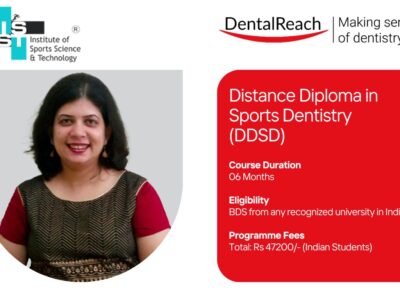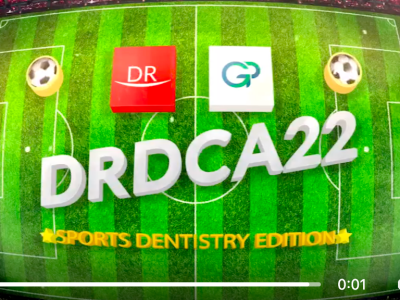Author Dr Stavros Avgerinos (Germany) is a Sports Dentist, Germany, Honorary President, Board Member of German Society for Sports Dentistry (DGSZM) and President of a professional ice hockey Club (EV Duisburg). Dr Stavros is a Keynote Speaker at the DentalReach Conference & Awards (DRDCA) 22: Sports Dentistry Edition. Brochure & Registration Link: Click here

In place of the usual introductory classification of the various types of sports mouthguards, a statement first:
” From the perspective of sports medicine, there is only one type of sports mouthguard”.
Since the first international symposium of the European Association for Sports Dentistry (EA4SD) in November 2019, and as part of the 6th European College of Sports and Exercise Physicians (ECOSEP) Sports Medicine Congress in Paris, there has been clarity about this statement in the sports dentistry world, which is now networking internationally.

During my presentation of the German Society for Sports Dentistry (DGSZM) one4all sports mouthguard (for use in all contact and collision sports), the minimum requirements for a sports mouthguard was defined in the presence of internationally acclaimed colleagues in research and practice. This was the first step towards a consensus on an international standard. The current state of studies (the authors of the vast majority of publications on this topic were present) as well as many years of experience was taken into account in this process.
Requirements of a mouthguard
A mouthguard manufactured according to the latest scientific criteria of sports dentistry must meet the following minimum requirements:
- Individually manufactured and multilayer laminated (hard component to distribute the applied force and soft/elastic component for absorption).
- Maximum possible protection of teeth, jaws, temporomandibular joint and surrounding soft tissues
- High wearing comfort
- Shock absorbing function (e.g. concussion prophylaxis)
- Fabrication for the maxillary arch (except in the case of pronounced Angle Class III)
- Option of disinfection
- Cost effectivity
- Occlusion considered and verified by a dentist
A discourse on classification, or even the use of pre-fabricated or individually fitted sports mouthguards is therefore obsolete and should, in my opinion, at least be critically reviewed by sports associations, cost bearers and, last but not least, politicians!
The DGSZM mouthguard
The German Society for Sports Dentistry (DGSZM) one4all sports mouthguard already fulfilled all the criteria listed years before the “Paris Agreement” and is continuously being further developed, taking into account current research results and feedback received from athletes. In this context, cost-effectiveness plays a very important role while maintaining high quality, because this is the only way to ensure widespread use in school, recreational and popular sports.
The materials, tools, equipment and work steps are clearly defined in terms of procedure and sequence, ensuring the reproducibility the maximum possible. In the next step, we are working towards a certification process in cooperation with the industry so that the trained colleagues can prove their qualifications and that the high standards are being maintained. For this purpose, the DGSZM will also offer international courses in cooperation with the Austrian Sports Dentistry Society (ÖGSZM), the EA4SD and probably also with the Academy for Sports Dentistry (ASD), USA. We are currently in exchange with further cooperation partners worldwide. In Germany, Austria and Switzerland, certification will be given as part of a continuum to the already very successfully established curriculum.
Materials & Design
Pre-laminated, three-layer splint material by Erkodent made from long-proven materials (EVA, COC) is used in this mouthguard, with two soft/elastic layers and a hard, highly reticulated intermediate layer. The manufacturing process corresponds to that of a single-layer splint with slight modifications to ensure the minimum incisal thickness and the optimum transfer of balanced occlusal conditions, ideally in myocentric bite position.
The DGSZM one4all sports mouthguard covers the vestibular part of the jaw exactly up to the mucobuccal fold. Palatally, it ends in a garland shape at the sulcus gingivalis, has impressions to ensure a balanced occlusion and a buccal or labial rampart to protect the teeth of the counter jaw.
Palatally, the outer soft/elastic layer has no function and is removed completely. The junction of the palatal part of the mouthguard to the free gingiva is smooth and hardly palpable for the tongue. Vestibularly, the outer soft/hard layer is also removed from the level of the mucogingival margin to the functional edge.
In the protective-only version, the mouthguard ends with the enclosure of the first molar. If a specific neuromuscular effect is to be achieved by implementing e.g. a myocentric bite registration, a specific modification of the expansion in the area of the 2nd molar is necessary.
Fabrication
Strict adherence to the production process and use of the recommended materials, equipment and instruments, from precise impression taking to insertion of the highly polished sports mouthguard, ensures predictable, consistently high quality results. Through continuous improvements the manufacturing efforts have been successively reduced, so that even for budgetary reasons it is no longer necessary to revert to industrially manufactured products.










The current version of the mouthguard offers the highest possible protection and can achieve a volume of less than 5 ml due to the applied reduction technology and intelligent dimensioning. In comparison, currently even in the American professional leagues sports mouthguards with well over 12 ml volume are in use with similar or even weaker protective performance. In addition, the three-stage lamination process that is often used increases the time required and the manufacturing costs significantly.
To conclude
It is certainly no coincidence that my experience from over 30 years as an athlete, dentist and ice hockey club president is absolutely in line with the scientific evidence in this area! However, it should always be kept in mind that the best sports mouthguard is absolutely useless if it is not worn. Increasing compliance is critical and all personnel involved can contribute to successful orofacial trauma prevention within the scope of their responsibilities.
The importance of sports dentistry in the team behind the team, or the individual athlete, is currently being redefined and the interdisciplinary connections are often enough astounding.
In this context, modern, constantly adapting fabrication techniques can be the decisive factor in the comprehensive supply for all athletes in contact sports with individually manufactured sports mouthguards. A fully digitalized production route is conceivable in the future, but currently not practical.




















Comments